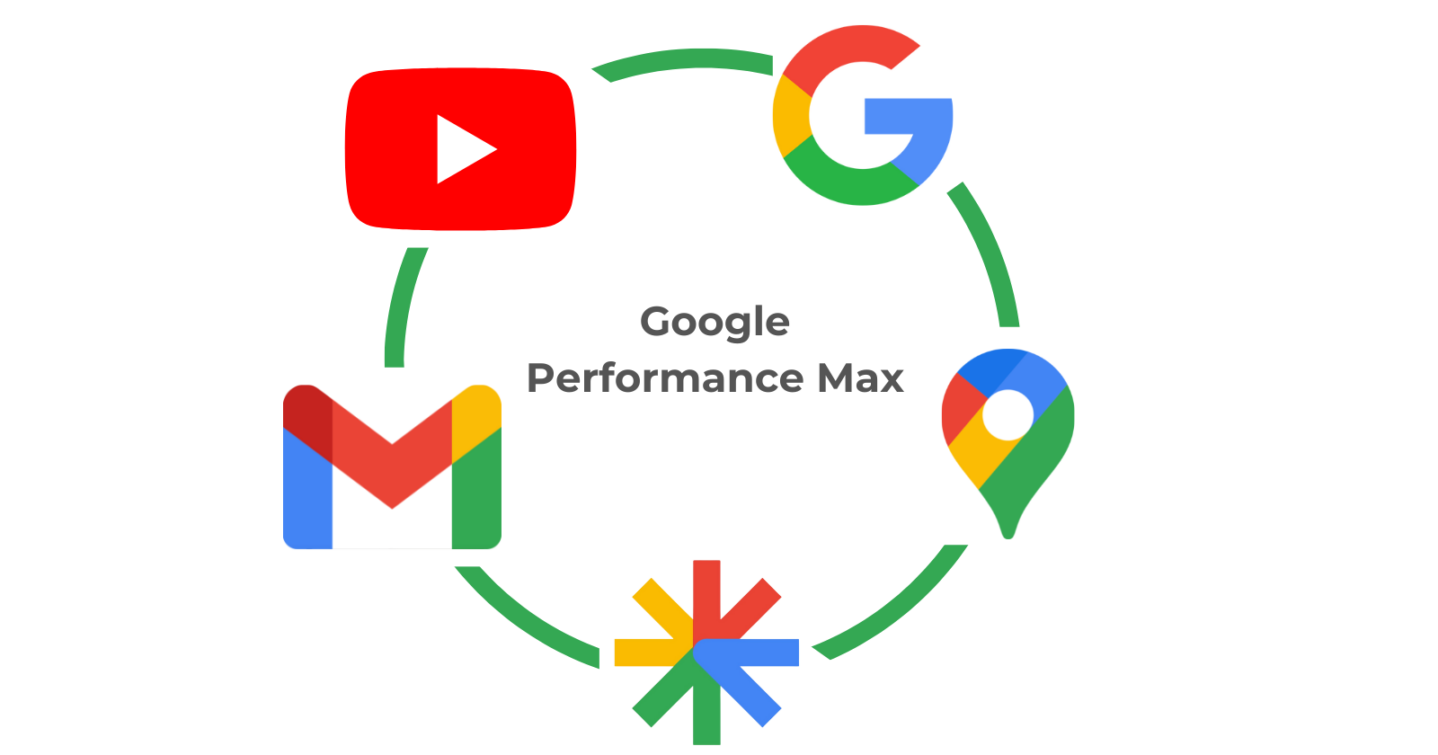Performance Max was introduced in 2022 and has since made waves throughout the marketing industry. With a higher focus on automation, it allows marketers to utilise Google’s various biddable media channels to increase conversions.
But are Performance Max ads right for your strategy? If so, what do you need to consider before implementing your campaigns? We’ll talk you through all this and more in our Performance Max guide.
Already know about Performance Max and just want to see how to set up a campaign? Click on the links below:
- What is Performance Max?
- When to use Performance Max campaigns
- What are the benefits of using Performance Max?
- What are the limitations of Performance Max?
- How to set up Performance Max campaigns
- Performance Max tips
What is Performance Max?
Google’s Performance Max is a type of goal-based campaign that improves the results of advertising campaigns. Performance Max Ads are displayed across the entire Google Network, with the search engine deciding which Ad to show where. It uses advanced algorithms and real-time performance data to optimise campaigns and make informed decisions about bidding, the process of which is automated.
Google designed Performance Max to complement keyword-based search campaigns by finding more users to target across Google’s different platforms (Display, Discover, YouTube, as examples). You have no control over which platform Google uses to display your Ads, but it covers a wide range which you may never have tested before with other campaigns.
Performance Max vs Shopping campaigns
Performance Max replaced Smart Shopping campaigns in 2022, combining elements of these and Local campaigns to suit today’s dynamic user behaviours. Now that purchasing journeys often involve multiple channels, Performance Max offers a smooth, simple way of targeting users in different formats.
There are a few differences between Smart Shopping and Performance Max in Google Ads, the main being the automated element of Performance Max.
As well as this, Performance Max includes Google Maps and Discover in its Ad coverage, and assets are sorted into Asset Groups, replacing the Ad and Product groups that came with Smart Shopping.
However, Smart Shopping did provide more detailed reports and accurate audience targeting, making it easier to find the right customers for your business. This was, of course, all done manually, by the digital marketer themselves.
How does Performance Max work?
Performance Max constantly adjusts bids in real-time based on the performance data it receives. Google uses machine learning to do this, but you do provide your own assets, just as you do in Responsive Display Ads. The algorithms take into account various factors such as audience, target cost per conversion, conversion history, and more to optimise Ad bids.
Performance Max works alongside existing Google Ads campaigns, such as Search, Display, and Video, as they use a different targeting approach. If a query exactly matches an Exact, Phrase, or Broad keyword within your existing campaigns, Google will prioritise your existing Search campaigns over Performance Max.
It’s worth noting that Performance Max takes priority over any other shopping campaigns. This means that Ads will be shown to users over any of your standard shopping campaigns.
Performance Max campaigns also allow advertisers to select specific audiences and targeting criteria, which can be used to exclude certain audiences that are already being targeted in other campaigns.
When running multiple campaigns, it’s important to monitor performance and adjust budgets and bidding strategies accordingly, to ensure the best return on investment. This all leads to your Performance Max performing as efficiently and smoothly as possible, showcasing your Ads across a variety of platforms and creating better results for your business.
When to use Performance Max campaigns?
Performance Max campaigns bring many benefits to your Biddable Media strategies, but you still consider whether you actually need to use it for your business. Performance Max is best used when:
- Your goal is to drive high-quality conversions and maximise Return On Ad Spend (ROAS)
- You have well-optimised assets, such as high-performing landing pages and relevant Ad creatives
- You have a clear understanding of your audience and can effectively target them using Performance Max targeting
If the above applies to you, then you may want to consider adding Performance Max to your digital marketing strategy. Just remember, you must use it alongside other biddable media campaigns – Performance Max is to enhance your Ads, not override any other campaigns you’re currently running.
What are the benefits of Performance Max campaigns in your digital marketing strategy?
So, what exactly are the Performance Max benefits?
- Improved efficiency and performance – Performance Max automates the bidding process and uses real-time performance data to make informed decisions, leading to improved efficiency and performance of your Ad campaigns.
- Increased ROI – by optimising campaigns in real-time, Performance Max helps to increase the Return On Investment (ROI) for your advertising spend.
- Real-time performance insights – Performance Max provides real-time performance insights, allowing businesses to make informed decisions about their campaigns and make adjustments as needed.
- Reduced manual effort – Performance Max automates the bidding process, reducing the manual effort required to manage campaigns.
- Increased conversions – by optimising campaigns in real-time, Performance Max can help increase the number of conversions generated from your campaigns.
- Better use of advertising budget – by improving the efficiency and performance of your campaigns, Performance Max can help ensure that your advertising budget is being used effectively to achieve the best results.
What are the limitations of using Performance Max campaigns?
While Performance Max has been successful for many businesses (we’ve helped our clients see some great results), there are some things to be wary of when implementing campaigns.
- Low level of control over targeting and performance data – Performance Max automates the bidding process, which can result in a lower level of control over targeting and performance data compared to manual bidding. You also don’t receive full access to campaign data, meaning that, with less transparency, it’s harder to remain in control of your Ads.
- Need to consult with Google representatives to add Negative Keywords – in order to add Negative Keywords to a Performance Max campaign, you may need to consult with a Google representative. However, there are rumours that we may soon be able to set account-level negatives, which would make our job slightly easier.
- Difficulty analysing campaign data – due to the automation of the bidding process and the real-time nature of Performance Max, it can be difficult to analyse campaign data and make informed decisions about performance.
- Risk of Performance Max cannibalisation – there have been issues where Performance Max bids on the same keywords as your other Ad campaigns, where they end up competing with each other. Google has taken steps to tackle this, such as prioritising your search campaigns if a query exactly matches an Exact, Phrase, or Broad keyword within your existing campaigns.
- Google has also announced that they’ll be rolling out negative keywords at an account level, meaning that you can exclude negative keywords from your entire account, reducing Performance Max cannibalisation risk.
In order to run a successful Performance Max campaign on Google Ads, it’s important to have a clear understanding of what success looks like for your campaigns. Once you know what you want to achieve, you can set clear and specific goals that will help you measure the effectiveness of your campaigns. Without these goals, you may not be able to fully optimise your campaigns and give them the best chance of success. By setting clear goals and regularly measuring and adjusting your campaigns based on their performance, you can ensure that your P-max campaigns are as effective as possible. Harry Pearson
How to set up Performance Max campaigns
If you decide to use Performance Max in your marketing strategy, it will need to be set up correctly. Let’s look at the asset requirements, optimising campaigns and tips to ensure you get the results you want to see.
Performance Max asset requirements
With a Performance Max campaign, there are a number of asset requirements to ensure your Ads are successful. All assets are grouped together into an Asset Group, and are mixed and matched by Google to suit the platforms on which your ads will be shown.
When setting up your campaigns, you want to follow the Performance Max creative requirements so your copy is high quality and your images look great on different screen sizes. Google lists the asset requirements here, but we’ve summarised them below:
- Target audience data – advertisers should have a clear understanding of their target audience, including demographic information and purchasing habits, to ensure that their campaigns are effectively targeted.
- High-quality images – Performance Max campaigns require high-quality images that are visually appealing and relevant to the products or services being advertised. The recommended specs needed are:
- Landscape image: 1200 x 628 px
- Square image: 1200 x 1200 px
- Portrait image 960 x 1200 px
- Logo: 1200 x 1200 px
- Landscape logo: 1200 x 300 px
- Relevant Ad copy – The Ad copy should be concise, grab users’ attention, and relevant to the products or services being advertised.
- Accurate product information – product information such as title, description, and price should be accurate and up-to-date to avoid misleading potential customers.
- Optimised landing page – it’s also worth noting that the landing page you’re sending users to should be optimised for user experience, Core Web Vitals and conversion rates. It needs to include relevant information about the products or services being advertised, and should be easy for users to navigate.
How to optimise Performance Max Campaigns
Performance Max campaigns are designed to bring success and perform well across a variety of platforms. There are a number of things you can do to enhance your campaigns as you set up and get things moving, maximising the benefits of each Ad.
- Define your campaign goals – clearly define your campaign goals and target cost per conversion to ensure that Performance Max is aligned with your desired outcomes.
- Choose the right audience – Audience signals are a crucial element of Performance Max, identifying the most relevant audiences for your goals. To select the right audience for your campaign, taking into consideration factors such as demographics, interests, and location. Best practices for using audience signals include:
- Use a mix of first and third-party data, such as website visitors, customer lists and lookalike audiences.
- Regularly review and update your audiences to ensure they’re relevant and effective
- Use audience exclusions to avoid targeting those unlikely to convert.
- Set a realistic target cost per conversion – establish a realistic target cost per conversion for your campaign to ensure that Performance Max is able to effectively optimise bids.
- Use conversion tracking – ensure that conversion tracking is set up and working correctly to provide Performance Max with the data it needs to make informed decisions about bidding.
- Monitor and adjust as needed – continuously monitor your campaigns and make adjustments as needed to ensure that Performance Max is effectively optimising bids and achieving desired results.
- Utilise real-time performance insights – make use of the real-time performance insights provided by Performance Max to make informed decisions about your campaigns and make adjustments as needed.
Optimising Performance Max campaigns is a continuous process that involves monitoring the right metrics, testing different asset combinations, and leveraging audience signals to enhance targeting. By staying up to date with the latest best practices and dedicating time to consistent optimisation, you can unlock the full potential of Performance Max and achieve your desired campaign objectives. Tamas Mihaley
Performance Max tips for setting up your biddable campaigns
One key thing that you shouldn’t do with your Performance Max campaigns is to set them up and then forget about them. There may be elements of automation involved but it doesn’t do everything for you! The key is to ensure Google has everything they need to really give your Ads the best chance of success, returning to
- Run campaigns for at least six weeks – we recommended to run Performance Max campaigns for at least six weeks to allow enough time for the algorithms to gather data and optimise performance
- Use as many assets as possible, such as ad copy and images, giving Google more data to work with.
- Use relevant audience lists as signals – utilise relevant audience lists as signals to help Performance Max better understand the audience and make more informed decisions about bidding.
Utilising audience signals in your Performance Max campaigns can certainly help guide Google to deliver your ads to the right people, but it’s important to keep in mind that these signals are only suggestive. In some cases, Google may still show your ads to audiences not explicitly included in your lists, so it’s essential to monitor and adjust your campaigns regularly to ensure optimal performance. – Tamas Mihaly
- Exclude brand terms and run in a separate standard campaign – exclude brand terms from Performance Max campaigns and run them in separate standard campaigns to avoid competing against yourself and distorting performance data
- Group categories – group similar categories together to provide Performance Max with more data and help it make more informed decisions about bidding
- Split your other Ad campaigns – consider splitting other campaigns into smaller, more targeted campaigns to provide Performance Max with more data and help it make more informed decisions about bidding.
- Refresh content frequently – regularly refresh content to keep campaigns engaging and relevant.
Performance Max campaigns with Loom Digital
Our PPC and Biddable Media experts have been implementing Performance Max for many of our clients, alongside other campaigns, and the results we’ve seen are fantastic. With all the tools and expertise needed to create assets and copy that hooks your audience, and will effectively manage your campaigns to ensure they bring you success.
By leveraging the power of machine learning and audience signals, Performance Max campaigns have the potential to revolutionise the way you advertise on Google. With a focus on driving specific goals and targets, and the ability to work alongside your existing campaigns, Performance Max can help you achieve better results and reach a wider audience. As you begin your journey with Performance Max, remember to optimise your assets, consult with Google representatives, and continually evaluate and adjust your strategies to maximise success. With dedication and perseverance, the possibilities are limitless. Tamas Mihaly
Get in touch today to find out more about our PPC services.





